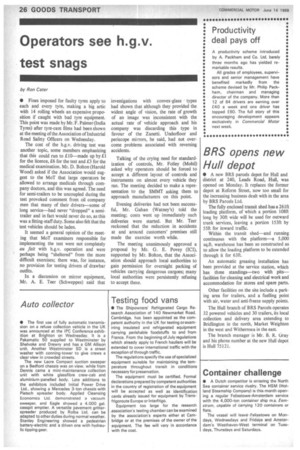Operators see h.g.v.
Page 28

If you've noticed an error in this article please click here to report it so we can fix it.
test snags
by Ron Cater
• Fines imposed for faulty tyres apply to each and every tyre, making a big artic with 14 rolling wheels an expensive proposition if caught with bad tyre equipment. This point was made by Mr. F. Palmer (India Tyres) after tyre-cart films had been shown at the meeting of the Association of Industrial Road Safety Officers on Wednesday.
The cost of the h.g.v. driving test was another topic, some members emphasizing that this could run to £10—made up by £1 for the licence, £6 for the test and £3 for the medical examination. Mr. D. Bolton (Harold Wood) asked if the Association would suggest to the MoT that large operators be allowed to arrange medicals through company doctors, and this was agreed. The need for semi-trailers to be uncoupled during the test provoked comment from oil company men that many of their drivers—some of long service—had never "dropped" a semitrailer and in fact would never do so, as this was a fitting-staff duty. Some also felt that the test vehicles should be laden.
It seemed a general opinion of the meeting that MoT examiners responsible for implementing the test were not completely au fait with h.g.v. operation and were perhaps being "sheltered" from the more difficult exercises; there was, for instance, no provision for testing drivers of drawbar outfits.
In a discussion on mirror equipment, Mr. A. E. leer (Schweppes) said that investigations with convex-glass types had shown that although they provided the widest angle of vision, the rate of growth of an image was inconsistent with the actual rate of vehicle approach and his company was discarding this type in favour of the Zanetti. Underfloor and periscope mirrors, he said, had not overcome problems associated with reversing accidents.
Talking of the crying need for standardization of controls, Mr. Folley (Mobil) asked why operators should be forced to accept a different layout of controls and instruments on almost every vehicle they ran. The meeting decided to make a representation to the SMMT asking them to approach manufacturers on this point.
Evening deliveries had not been successful, Mr. Gahan (Watney's) told the meeting; costs went up immediately such deliveries were started. But Mr. Teer reckoned that the reduction in accidents at and around customers' premises still made the exercise worth while.
The meeting unanimously approved a proposal by Mr. G. E. Povey (id), supported by Mr. Bolton, that the Association should approach local authorities to gain permission for overnight parking of vehicles carrying dangerous cargoes; many local authorities were persistently refusing to accept these.




























































































































